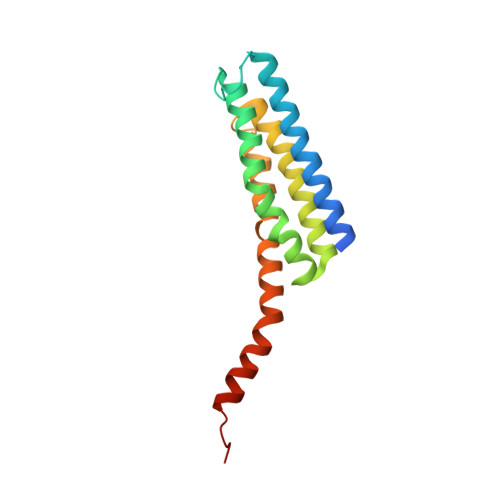Phosphorylation of Leukotriene C4 Synthase at Serine 36 Impairs Catalytic Activity.
Ahmad, S., Ytterberg, A.J., Thulasingam, M., Tholander, F., Bergman, T., Zubarev, R., Wetterholm, A., Rinaldo-Matthis, A., Haeggstrom, J.Z.(2016) J Biol Chem 291: 18410-18418
- PubMed: 27365393
- DOI: https://doi.org/10.1074/jbc.M116.735647
- Primary Citation of Related Structures:
5HV9 - PubMed Abstract:
Leukotriene C4 synthase (LTC4S) catalyzes the formation of the proinflammatory lipid mediator leukotriene C4 (LTC4). LTC4 is the parent molecule of the cysteinyl leukotrienes, which are recognized for their pathogenic role in asthma and allergic diseases. Cellular LTC4S activity is suppressed by PKC-mediated phosphorylation, and recently a downstream p70S6k was shown to play an important role in this process. Here, we identified Ser(36) as the major p70S6k phosphorylation site, along with a low frequency site at Thr(40), using an in vitro phosphorylation assay combined with mass spectrometry. The functional consequences of p70S6k phosphorylation were tested with the phosphomimetic mutant S36E, which displayed only about 20% (20 μmol/min/mg) of the activity of WT enzyme (95 μmol/min/mg), whereas the enzyme activity of T40E was not significantly affected. The enzyme activity of S36E increased linearly with increasing LTA4 concentrations during the steady-state kinetics analysis, indicating poor lipid substrate binding. The Ser(36) is located in a loop region close to the entrance of the proposed substrate binding pocket. Comparative molecular dynamics indicated that Ser(36) upon phosphorylation will pull the first luminal loop of LTC4S toward the neighboring subunit of the functional homotrimer, thereby forming hydrogen bonds with Arg(104) in the adjacent subunit. Because Arg(104) is a key catalytic residue responsible for stabilization of the glutathione thiolate anion, this phosphorylation-induced interaction leads to a reduction of the catalytic activity. In addition, the positional shift of the loop and its interaction with the neighboring subunit affect active site access. Thus, our mutational and kinetic data, together with molecular simulations, suggest that phosphorylation of Ser(36) inhibits the catalytic function of LTC4S by interference with the catalytic machinery.
Organizational Affiliation:
From the Divisions of Chemistry II.
















